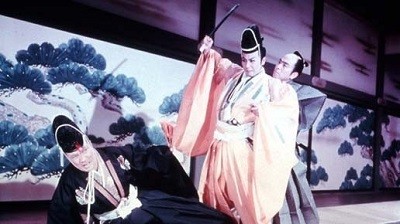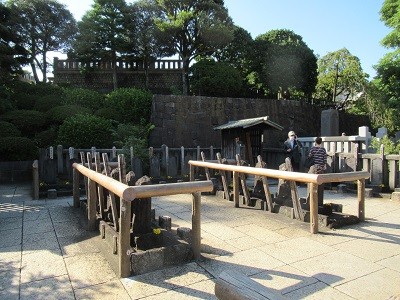Sengakuji is a Buddhist temple of the Soto Sect in Tokyo. The temple was constructed in 1612 by the first shogun Tokugawa Ieyasu. It got burned down in 1641, but 3rd shogun Iemitsu ordered its reconstruction. It is a famous and popular temple among history lovers because the tombs of the Akoroshi, also known as the 47 ronin, are here. The 47 ronin had to kill themselves in the Ako Incident explained below. It is a violent and sad story, but Japanese people love it.
Ako Incident
The Ako Incident is also called ‘Chushingura’, which comes from the historical story’s Kabuki and Joruri puppet show title. Chushin means ‘loyal servants’. In 1701, feudal lord Asano Takuminokami from Ako in Hyogo attacked Kira Kozukenosuke, who was an upper vassal of Tokugawa shogunate at Edo Castle and could therefore use a sword.
It is unknown why he attacked. Some say Asano refused a bribe from Kira and then Kira did nasty things such as not giving important information to Asano, so Asano got angry. Asano attacked Kira, but Kira got only a small injury because his attack was stopped by witnesses of the attack.

Anyway, it was strictly prohibited to use swords in the shogun’s castle, so Asano got the death penalty. In fact, he was sentenced to commit ‘seppuku‘, meaning he had to cut his own stomach. His body was then buried at the Sengakuji Temple. Kira, on the other hand, didn’t get any punishment, and the shogun even gave him a thoughtful word.
The chief retainer of Ako domain was Oishi Kuranosuke. The messenger from the shogunate gave him an official letter which said that they had to leave the castle. He didn’t move at first in protest. But because this action might cause trouble to Asano’s brother and relatives, he decided to leave the castle and return it to the shogunate. This was how the Ako Domain was dissolved.
Revenge
Kira received no punishment at first, but his reputation has been tarnished. Kira resigned from this title and he was ordered to move from the center to the suburb.
The vassals of Asano didn’t think that this was enough and were still angry, so they planned to kill Kira for revenge. At that time, revenge for a father frequently happened, but revenge for a master did not. They got together in Edo (former name of Tokyo) and had secret meetings. The leader of these angry samurai was Oishi. Finally, 47 members decided to attack Kira for revenge. By the way, ronin means ‘samurai without a master’. They lost their lord and their domain had dissolved.
In December 1703, two and half years after the incident in the castle, the ronin attacked Kira’s house and killed him. There were 15 deaths on Kira’s side, but no one died on Asano’s side. They cut Kira’s head off and brought it to the grave of their master Asano in the Sengakuji. After offering incense, everyone hit the neck of Kira’s head with a small sword, and that was Asano’s remembrance.
After the revenge, all ronin were sentenced to seppuku by the shogunate. Their bodies were buried at the Sengakuji close to their master Asano’s grave.
In the Sengakuji Precinct
Statue of Oishi Kuranosuke: This bronze statue was made in 1921. He is wearing a traditional Haori coat and holds the petition in his hand while looking up at the sky.
Graves: In the back, you can find the grave of Asano Takuminokami and his wife. You can see the 48 graves of the vassals close by. The reason there’s 48 is that one was added because one of the vassals committed seppuku before the attack because his family was opposed to the revenge plan.

Head Washing Well: Before the ronin put Kira’s head in front of Asano’s grave, they washed the head in this well.
Bunraku and Kabuki Title
About 50 years in 1748, this incident became a Bunraku program. Bunraku is a traditional puppet show which is still played today. But they couldn’t use the real names and story because it accuses the shogunate, so they modified the story.
The title is “Chushingura”. Chushin means loyal vassals and Kura is a part of the name of the leader Oishi Kuranosuke. It became a Kabuki program, too. People at that time loved the story. Though it was a murder, they did it for their master. Many movies were made about this story in the 20th century, and it is still loved by many people even today.
Ako Gishi Festival
A remembrance festival is held every year on December 14th. This is the day of the attack on Kira’s house in 1703. People visit the temple to offer incense and pray for the dead, and a parade of 47 ronin wearing their old uniform is held.
Your Japan Tour
As seasoned Japan experts, we can help you create your perfect Japan tour including guides who can tell you all about stories like the 47 Ronin. The guide can take you to the Sengakuji Temple if you wish.Contact usto start planning your unforgettable holiday to this fascinating country. Japan is full of once-in-a-lifetime experiences, culture, history, nature, and delicious food!
Sengakuji Access Information
Access: 1 minute-walk from Sengakuji Station of Keikyu Line or 6 minutes-walk from Takanawa Gateway Station of JR Yamanote Line.

